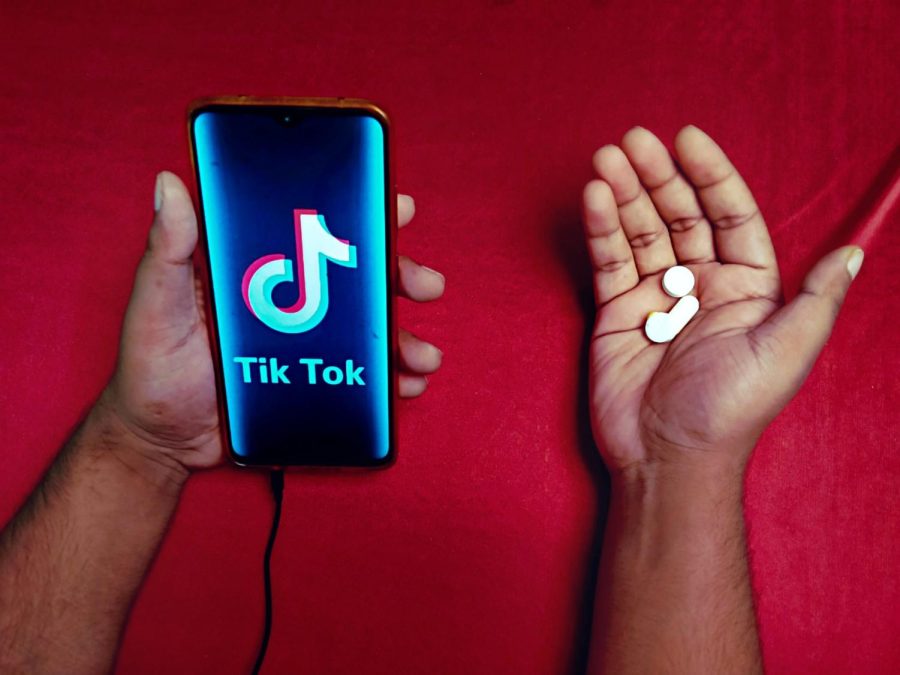Teens show symptoms of Tourette’s Syndrome, some blame TikTok
Some teens have been showing an increase of Tourette’s Syndrome symptoms. Some researchers are blaming Tik Tok.
Nov 12, 2021
As TikTok continues to grow in popularity, users across the globe have begun engaging with the social network multiple times a day. A variety of creators from multiple aesthetics have not only increased their content production, but also made their content more candid at the same time. Now, it is commonplace to scroll through the application and see a user on a livestream cooking their dinner, watching a movie or simply talking to the audience tuning in to their page.
As of September 2021, TikTok had over one billion active users, surpassing Snapchat at 500 million and closely following Instagram at 1.4 billion. TikTokers are staying on the app too; the average user spends 52 minutes a day scrolling through their feed. Most of those on the app are in Generation Z and 80% of users are between the ages of 16 and 34.
As TikTok’s audience grows, so do its creators and the topics they cover. A myriad of consumers on the platform have begun having open and honest conversations with their followers both through their live feed or through video uploads. The subjects discussed range from relationship issues, financial problems and mental health struggles.
One prevalent malaise which has adopted a multitude of hashtags on the application is Tourette’s Syndrome, or TS, a neurological disorder categorized by a sudden onset of spasmodic behavior. The Center for Disease Control and Prevention classifies these outbursts, also known as tics, as “sudden twitches, movements, or sounds that people do repeatedly.” The CDC goes on to say that it is difficult to both diagnose and treat TS because there is no outright cure for the ailment; adaptation of the condition to everyday life is the most prominent strategy among those impacted by TS along with behavioral therapy and medication.
I guess uncommon but not rare is probably the best way to describe it.
— Dr. Thomas Frazier, JCU Psychology Professor
The CDC says that approximately 1 out of 162 children are diagnosed with TS and that 44% of those cases are either moderate or severe. Glamour Magazine estimates that 300,000 people in total in the United Kingdom have been diagnosed with Tourette’s, but the actual number could be higher; especially now that teenagers on TikTok have begun experiencing TS symptoms at an alarming rate.
“Tourette’s is not rare but it is also not one of the more common disorders,” Dr. Thomas Frazier, a psychology professor at John Carroll University, told The Carroll News. “I guess uncommon but not rare is probably the best way to describe it. The CDC has put the prevalence at 1 in 333 children ages 5-17.”
Glamour goes on to say that #Tourettes on TikTok has over 4.9 billion clicks and counting. As the views of this trend rose, so did subsequent TS cases. A researcher, Dr. Caroline Olvera, stated that “19 of the 28 most-followed influencers with TS on TikTok reported developing new tics as a result of watching other creators’ videos.” Cases for TS have also skyrocketed within the United States since January 2021, with the number of diagnoses doubling from 2020.
WFLA, a news site in Tampa Bay, Florida, interviewed a teenager who developed tic-like behavior after watching TikToks. Summer Hope, the creator with TS, said she is scared that her followers may be picking up on her tics after watching her content repeatedly.
The Archives of Disease in Childhood conducted a study examining the connection between the increase in reported TS cases. One of the possible causes discussed is mimicry. Mimicry is defined by Alley Dog, a psychology student resource, as “the behavior of observing and replicating the actions of others… essentially the social imitation of others.” TikTok users watch their favorite creators experience Tourette’s and begin to mimic the behavior.
The cause for mimicry is unknown, but it is attributed to learning foundational skills like walking and talking at a young age. It is a behavior humans pick up as infants and carry throughout their life as an evolutionary benefit especially in social situations. Yet, like with the case of TS and TikTok, it can often be detrimental. Acquiring harmful habits at such a malleable age often leads to teenagers delving into baleful activities later in life.
“I think mimicry likely plays a very minor role,” Frazier stated. “These are neurological disorders that result from changes to structures involved in the development and maintenance of habitual behavior. Mimicry is something we all do, especially as children but even as adults, and yet most people don’t develop Tourette’s. It is possible though that some mimicry can contribute to the exact expression of a tic or involuntary movement.”
However, the new increase in Tourette’s cases can not only be attributed to popular viewership on the video-sharing platform, but also a change in environmental factors. Dr. Joseph McGuire from John Hopkins University’s Tourette Center says that “there are a lot of contributing factors, including anxiety, depression and stress.” The pandemic likely exacerbated the tension these teenagers experienced, potentially aggravating conditions that lead to the development of tics. Regardless of the root cause, the rapid spike in Tourette’s reports is likely to continue to concern researchers and social media users alike.














